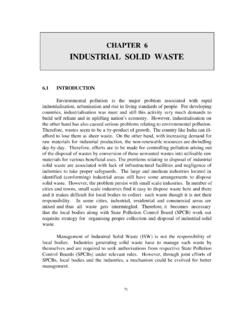Transcription of Introduction & Acknowledgements - Empire State College
1 Introduction & Acknowledgements The purpose of this fact book is to present a basic economic overview of the contemporary construction industry and the people who work in it. We live and work in the shadows of skyscrapers and make our way through streets shaped by multistoried apartment buildings, small shops, abandoned factories, houses and brownstones. Our breath may be taken away by the majesty of a building or we might be awed by the intricate patterns of brick, steel and cables we see around us. But usually we continue on our way, quite oblivious to the vast industry responsible for shaping the environments in which we live and work. This fact book has been developed for workers and students in the construction industry, as well as for any of the general public who might be curious about this dynamic segment of our economy a trillion dollar industry nationally, employing over 6 million people.
2 This fact book began as a project of the Research Methods: Labor Strategy and Structure, Spring 2006 class at The Harry Van Arsdale Jr. Center for Labor Studies in New York City. Thank you to all my students whose hard work began shaping this project. Updating and expanding the fact book will be an on-going student endeavor. Thank you to the State of New York/United University of Professions Joint Labor-Management Committees for supporting this project. Thank you to Michael Merrill, Dean at Van Arsdale, for his advisory assistance, to Moshe Adler for his contributions as noted in the Fact Book, and to Howard Saunders for his graphics. Sharon Szymanski, The Harry Van Arsdale Jr. Center for Labor Studies Empire State College /SUNY 325 Hudson Street, 6th Floor New York City 10013 Table of Contents What is the Construction Industry? .. 4 How Large is the Public Sector Construction Industry?
3 5 Wages in the Construction Industry .. 6 Upstate and Downstate: Two Labor Markets? .. 9 Who Works in the Construction Industry? .. 10 Gender in the Construction Industry .. 12 Education in the Construction Industry .. 13 Union Membership in the Construction Industry .. 15 Health and Safety in the Construction Industry .. 18 The Construction Industry s Role in the Economy .. 19 The Cyclical Nature of Employment in the Construction Industry .. 21 The Structure of the Construction Industry .. 23 1 What is the Construction Industry? The construction industry is traditionally divided into three sub-sectors. They are: 1) the construction of buildings; 2) road, highway, and other infrastructure construction; and 3) specialty trades. It thus encompasses all the businesses that build either houses and office buildings or highways and bridges, as well as those who do the specialized work of electricians, plumbers and masons, who are typically involved in the construction of all kinds of structures.
4 The construction industry is a significant part of our economy, employing over 8 percent of all wage earners. Of the 14 industry-categories used below, construction ranked sixth in the percentage of the total workers it employed in 2006. Table 1: Employment by Industry: Percent of Total Employed INDUSTRY 2000 2006 Education & Health Services Retail Trade Manufacturing Professional & Business Services 10 Leisure & Hospitality CONSTRUCTION Financial activities Transportation & Utilities Other Government workers Wholesale trade Information Agriculture Mining .3 .5 Source: Census Bureau, Statistical Abstract of the 2007, Table 606 for 2000 data. Bureau of Labor Statistics, Household Data Annual Averages, Table 17. Employed persons by industry, sex, race and occupation, for 2006 data. 2 How Large is the Public Sector Construction Industry?
5 The annual total value of construction put in place is over a trillion dollars -- $1, billion. Of this, almost 76 percent is in the private sector and 24 percent in the public sector State , local and federal. In the private sector, residential construction makes up 61 percent of all projects, while office and commercial construction account for only 15 percent. Table 2: Value of Private Sector Construction (in millions of dollars) May 2007 Percent TOTAL PRIVATE CONSTRUCTION $892,114 100% Residential 548,989 62 Non Residential 343,125 38 Commercial 81,674 9 Office 51,979 6 Manufacturing 38,215 4 Power 37,553 4 Health care 36,951 4 Lodging 27,770 3 Communication 26,385 3 Educational 15,711 2 Religious 7,656 1 Amusement & recreation 9,090 1 Transportation 8,303 1 Source: Census Bureau Construction Spending, In the public sector, educational facilities represent 28 percent of all publicly-funded construction, followed by highway and street construction at 27 percent.
6 Table 3: Value of Public Sector Construction (millions of dollars) May 2007 Percent TOTAL PUBLIC CONSTRUCTION 284,456 100% Residential 7,030 3 Non Residential 277,426 98 Educational 79,667 28 Highway and street 76,428 27 Sewage & waste disposal 23,969 8 Transportation 21,255 8 Water supply 15,441 5 Power 12,111 4 Amusement & recreation 11,084 4 Office 9,371 3 Public safety 9,117 3 Health care 8,892 3 Conservation & development 5,268 2 Commercial 3,464 1 Source: Census Bureau Construction Spending, 3 Wages in the Construction Industry In general, unionization has a significant impact on the pay and benefits of union members. As Table 4 shows, while there is a significant union premium in both wages and benefits, the union advantage is greatest for benefits. Union members receive health, education, vacation, and retirement benefits that are significantly greater than those non-union workers receive.
7 According to the most recent data, in 2007, union members had median weekly earnings of $863 while those not represented by unions had median weekly earnings of $ Table 4: The Union Hourly Wage and Benefit Premium, 2005 All Workers: Wages Insurance Pension Compensation Union $ $ $ Non-union $ $ $ $ Union Premium: Dollars $ $ $ $ Percent 28 136 232 44 Source: L. Mishel, J. Bernstein, S. Allegretto, The State of Working American 2006/2007, The Economic Policy Institute, Cornell Press, 2007, Table The union premium in the construction industry is also quite significant. The union advantage in all the selected occupations shown in Table 5 is greater than fifty percent. Table 5: Average Hourly Pay and Yearly Earnings for Selected Construction Occupations, Union and Non-Union, 2006 Occupation Union Hourly Wage Union Yearly Earnings Nonunion Hourly Wage Nonunion Annual Earnings Union Advantage Carpenters $ $54,933 $ $30,534 80% Electricians $ $55,494 $ $36,629 52% Construction Laborers $ $46,946 $ $26,208 79% Roofers $ $42,723 $ $26,541 61% Pipelayers, Plumbers, Steamfitters, Pipefitters $ $55,245 $ $34,882 58% Painters $ $44,720 $ $25,813 73% Sheet Metal Workers $ $51,979 $ $33,800 54% Cement Masons, etc.
8 $ $51,790 $ $30,618 69% Brick and Stone masons $ $45,718 $ $28,330 61% Drywall Installers, Ceiling Tile Installers, Tapers $ $49,296 $ $26,811 84% Source: Barry T. Hirsch and David A. MacPherson, Union Membership and Earnings Data Book, BNA, 2007, forthcoming; Census Bureau, Preliminary Estimates of Weighted Average Poverty Thresholds for 2006, January 24, 2007. From: 1 Bureau of Labor Statistics, Union Members in 2007, [25 Jan 2008], release/ , Tbl 2. 4In New York City Region construction trades workers can earn from $16,000 to over $50,000 per year when they enter the industry, and from $30,000 to over $80,000 as they become more experienced Table 6: Wages for NYC Region Construction Occupations, 2nd Quarter 2007* Employment Mean Entry Annual Wages Experienced Annual Wages First line Supervisors/Mangers 8,870 $85,790 $55,510 $100,920 Structural Iron & Steel Workers 1,270 $74,870 $38,420 $93,090 Operating Engineers & Other Construction Equipment Operators 2,360 $80,200 $55,130 $92,740 Electricians 17,390 $70,170 $41,420 $84,540 Plumbers, Pipefitters, Steamfitters 11,070 $63,140 $36,260 $76,580 Reinforcing Iron and Rebar Workers n/a $74,710 $51,720 $86,200 Drywall and Ceiling Tile Installers 1,550 $60,730 $37,390 $72,400 Plasterers and Stucco Masons 610 $55,310 $38,590 $63,670 Helpers -- Brick & Stone masons, Tile & Marble Setters 600 $50,230 $22,520 $64,090 Sheet Metal Workers 2,330 $63,110 $32,350 $78,490 Brickmasons and Blockmasons 2,140 $57,200 $38,620 $66,490 Carpet Installers n/a $59,870 $31,850 $73.
9 880 Tile and Marble Setters 1,100 $59,380 $33,310 $72,420 Stonemasons n/a $54,040 $30,500 $65,810 Carpenters 14,160 $58,270 $33,310 $70,740 Painters, Construction & Maintenance 5,240 $52,460 $27,830 $64,770 Construction Laborers 13,180 $50,690 $26,070 $63,010 Roofers 1,340 $48,990 $26,510 $60,230 Glaziers n/a $41,010 $21,600 $50,710 Pipelayers n/a $44,350 $26,800 $53,120 Helpers - Electrician 1,460 $36,380 $25,560 $41,790 Helpers Pipelayers ,Plumbers, Pipefitters, Steamfitters 1,670 $33,290 $20,860 $39,500 Helpers Painters, Paperhangers, Plasterers, Stucco Masons n/a $28,620 $19,620 $33,130 Helpers Carpenters 1,760 $27,980 $18,150 $32,900 *Wage data are from the 2003 -2006 OES Survey and have been adjusted to second quarter 2007 by making cost-of-living adjustments, reflecting NYS minimum wage of $ NYC Region includes Bronx, Kings, NY, Queens and Richmond counties.
10 Source: 2 Entry wage is the mean (average) wage of the bottom third of wages in an occupation. Experienced wage is the mean (average) wage of the top two-thirds of wages in an occupation. 5 Electricians and plumbers earn some of the highest wages in the trades, not only because they are the most unionized, but also because these occupations require either an apprenticeship system (for electricians) or a license (for plumbers) to practice. The apprenticeship program established for non-residential electricians includes career ladders with corresponding pay increases such that entry-level electricians earn over $40,000 on entering the trade and experienced electricians can earn over $80,000 per year. In contrast, a growing number of construction workers in the New York City residential sector are working off the books, receiving low wages and no union benefits or protection.





